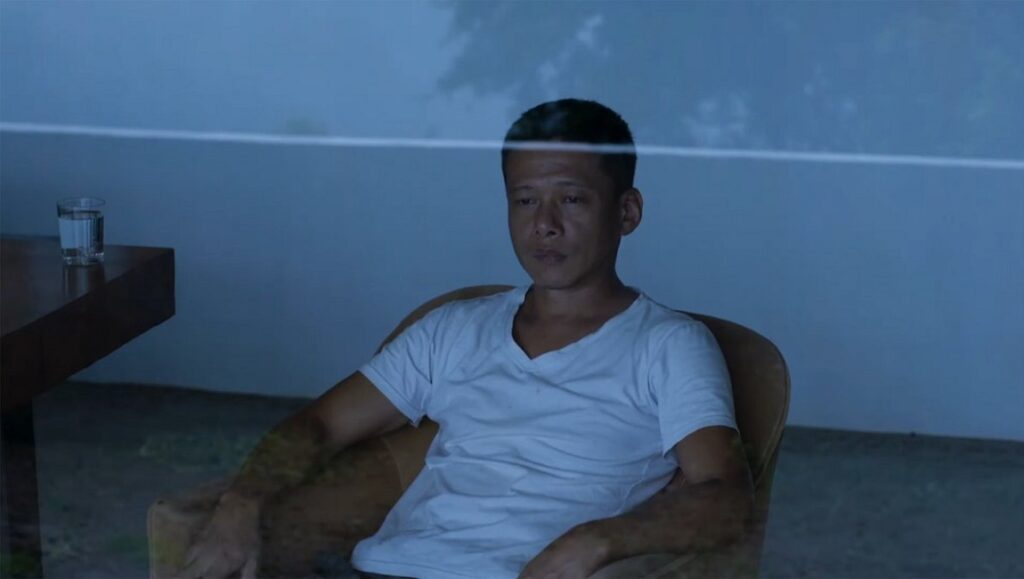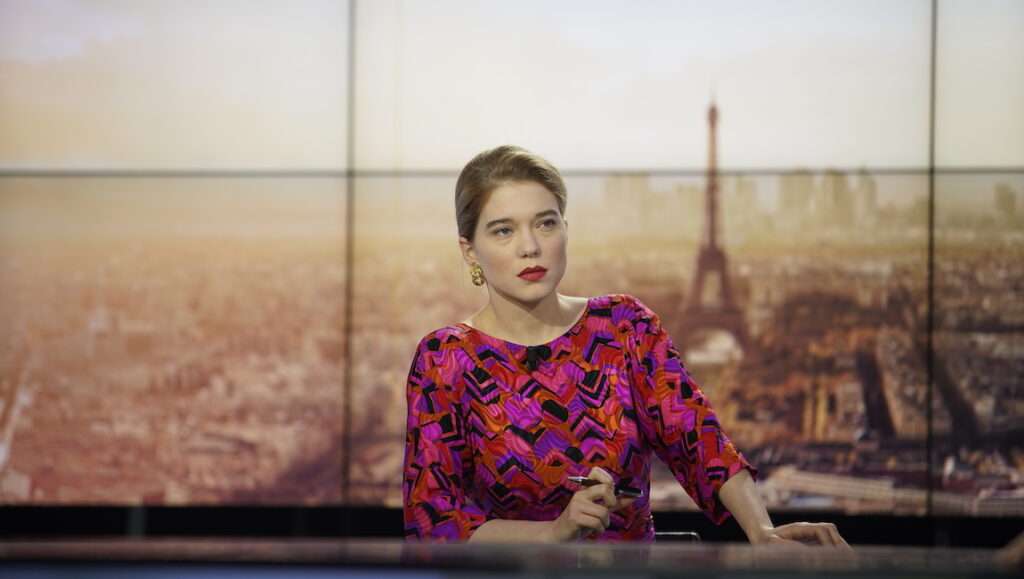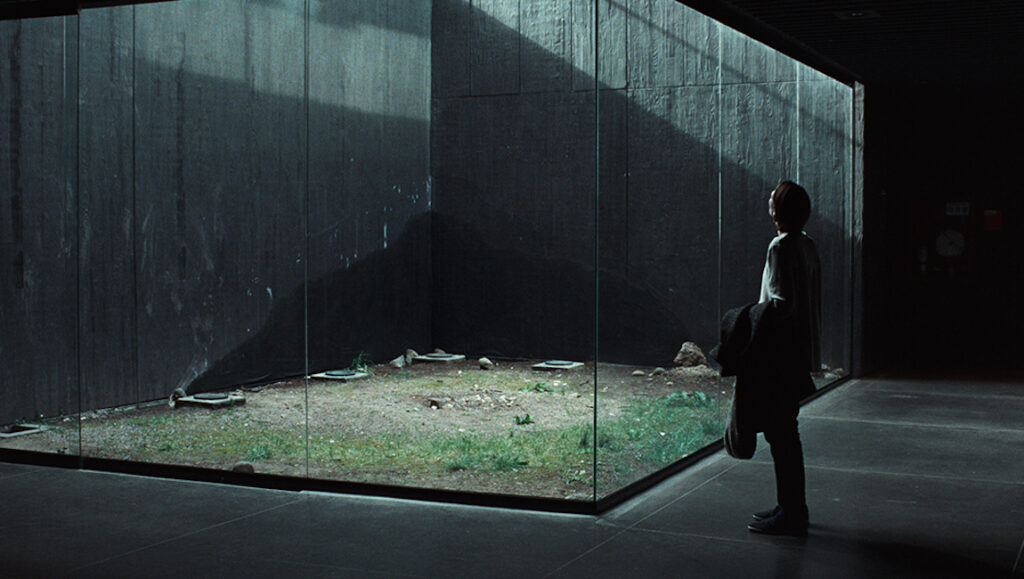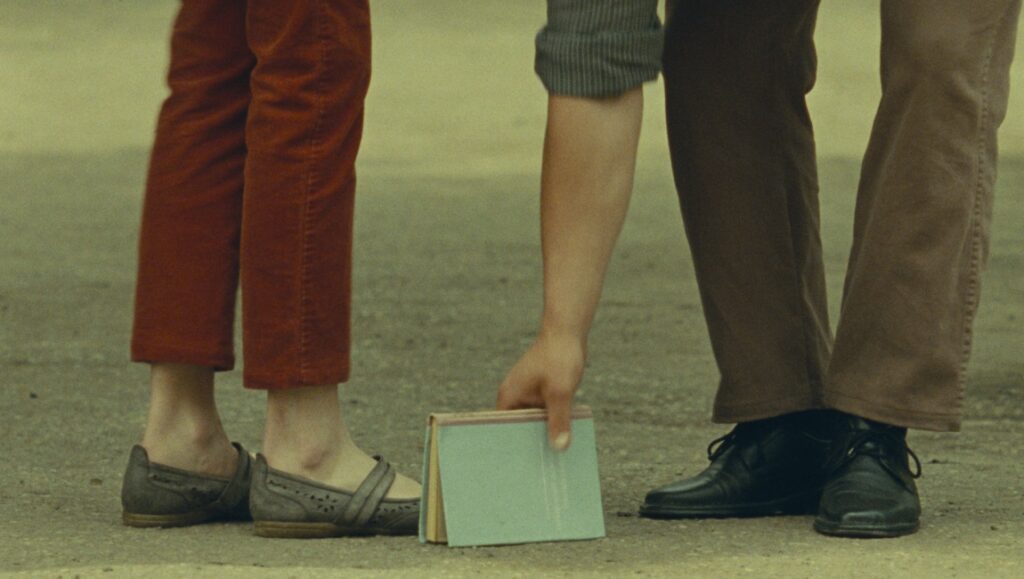And with that, our Top Films of 2021 coverage comes to a close, with our five favorites talked up below. All films, even if we previously covered them, have been revisited with new words and new writers. Check out our full Best Films coverage (including our Honorable Mentions), and if you’re so inclined, check back next week for our favorite albums of 2021!

5. Days
Premiering in competition at 2020’s Berlinale and winner of its jury Teddy Award (for LGBT cinema), Tsai Ming-liang’s Days very much continues and deepens its director’s trademark minimalism, here going so far as to renounce attempts to extrapolate a storyline over its characters. More austere than Stray Dogs, his 2013 post-apocalyptic masterpiece notorious for its final 14-min shot of a mural, and an even further cry from the auteur’s 1992 breakthrough Rebels of the Neon God, in which Tsai’s poetic sensibilities were heavily infused with punkish ennui, Days arguably constitutes the summation of Tsai’s artistic, working, and personal careers. For one, his longtime collaborator and muse Lee Kang-sheng appears in one of the only two roles. (Lee has appeared in all of Tsai’s films, feature or documentary, and was cited by the director as the “sole reason” he continues to make films.) His onscreen presence inseparable from Tsai — from a wayward student in Rebels to the disillusioned salesman in Vive L’Amour to a devastated and impoverished father in Stray Dogs — Lee ages alongside Tsai’s filmography, charting the often solitary life of a film icon through his tumultuous decades of acting, aging, and physical ailments.
And yet, something about Days strongly suggests a finality to it, more so than Tsai’s self-purported retirement after Stray Dogs (which concluded with his signature right before the end credits). Where Stray Dogs had the semblance of a narrative, even courting discussion over its supposedly elliptical presentation, Days remains firmly a faithful representation of observed reality, its formal rigor reminiscent of James Benning and Helena Wittmann. This discipline trains the viewer’s focus onto the image, distilling its ever-minute shifts, patterns, rhythms — subjects whose sheer existence has long been undermined with the advent of film, its storytelling modes, its editing (Kuleshov or otherwise), and its incapacity to be employed in service of the analytical calm that has come to shape its painterly and photographic predecessors. If it should be labeled as soporific and pointless, then so be it.
Lee’s visage, of a man now fifty, opens the film; he sits in a house by the countryside, staring at the pouring rain outside. Soon after, a younger man enters the picture but not the frame; played by Laotian newcomer Anong Houngheaungsy, the man dwells in a city apartment, gracefully engaging in tasks of mundane beauty, such as stoking a fire, washing and plucking vegetables, etc. The two men go about their separate lives, and slowly we begin to wonder how each is ever connected to the other; are they estranged relatives or ex-lovers, or complete strangers whose lives realize some semblance of harmony despite never having met? It is only an hour into the film when they are brought within the same frame. The moment is sudden: Lee has booked a hotel room in the city, where he answers a text on his cellphone, before stripping and laying face-down on the bed, following which two hands, Houngheuangsy’s, inch their way into the frame and onto his legs, caressing them in the foreplay to their massage session. The latter is very much a prostitute in this exchange, servicing — over two unbroken shots lasting nineteen minutes in total — Lee’s aging yet Adonic body, weathered over time yet oiled and erotically lustrous, before culminating in an off-screen but no less cathartic climax.
The refusal to qualify the lives of both men with plot points or cursory suggestions of their loneliness or homosexuality, doing away with the depiction of events leading up to their encounter, marks a radical departure in cinematic representation (though a pretty commonplace style of Tsai’s) in which the adage of “show, not tell” is taken to its semantic extreme. It is also a deeply humanist endeavor, relegating the political concerns that distinctly marked Stray Dogs, et al. to a backdrop and dispensing with class, language, ethnic, and age boundaries altogether in portraying the ebbs and flows of two separate narratives which, for a brief moment in the eons of banality and repetition, cross each other. Coupled with Tsai’s emphasis on corporeality, of bodies and spaces often sidelined by the ferocities of montage and incident, Days takes on a diaristic role in documenting the days and lives of men with muted yet dignified splendor. Morris Yang

4. France
Bruno Dumont’s France is “about” the contemporary media landscape in the way that Dreyer’s The Passion of Joan of Arc is “about” the 15th-century judgments of the French clerical court. This is also to say that if one focuses on the films’ respective historical contexts, it may be difficult to see how either could be remotely considered great. But France is indeed great, in large part because of Dumont’s interest in his heroine’s predicament not as trial, but as passion. Following 2019’s Jeanne, his second film about the teenaged Maid of Orleans, Dumont turned his eye to the present, casting Léa Seydoux as France de Meurs, a celebrity journalist subject to all the scrutiny and attention that such a position entails. But his approach remains much the same in both films: He focuses on neither the vagaries of historical circumstance nor the supposed “truth” or “falsity” of his heroines’ actions, but on the affective qualities that transcend history — those aspects of an event that are expressed in themselves, and which are irreducible to the tyranny of historical cause and effect. Dumont focuses, in other words, on singular qualities expressed by Seydoux’s face, which the camera continually pushes into and holds on, as if searching for proof of things unseen.
The French writer Roger Leenhardt once remarked that close-ups make all faces look alike, turning all non-made-up faces into Falconetti and all made-up ones into Greta Garbo. Watching Seydoux across France, we do feel something of this: The film hinges on our capacity to push past its deliberate contrivances of plot and event, and witness the specific strangeness of France’s presence, communicated largely through close-ups of Seydoux, who uses face as a contortionist would their body. The film’s interest lies not in the supposed authenticity of the emotion conveyed in any given scene, but in something arguably far more mysterious: the fact that we are even able to recognize in France’s face — in any face — such things as “pain” and “sadness” and “sorrow” in the first place. Toward the end of the film, Dumont returns to L’humanité (1999) in both setting and substance, following France as she interviews a woman whose husband raped and murdered a young schoolgirl. Following this intense, sobering encounter, France steps outside of the woman’s house and, gazing out at the surrounding landscape, simply remarks, “It’s beautiful.” It is not a statement with which we can really agree or disagree; judgment seems to have no place any longer. One trial is over; another has yet to begin. But in between the two, France’s passion remains. Lawrence Garcia

3. Drive My Car
Of all the innumerable gambits and devices that Ryūsuke Hamaguchi deploys in his immense Drive My Car, his particular use of language may be the most beautiful and fundamental. On some level, this has almost been taken for granted: the film is an expanded adaptation of a Haruki Murakami short story, Kafuku (Nishijima Hidetoshi) is a theater director and actor, and the staging of Uncle Vanya at the Hiroshima festival draws all the characters introduced after the first forty minutes into the same orbit. And so it’s natural that so much time would be dedicated to the analysis of speech, to paying particular attention to dialogue and its structure in a manner that some might not associate as stringently with a typical arthouse film, even one as relatively accessible as this one. But Hamaguchi’s fascination goes even deeper than that. Kafuku presents a concise yet mystic summation of Chekhov that might be taken as something of a mission statement for the film, stating that he has refused to play Vanya because “when you say his lines, it drags out the real you,” something that cannot be borne by a man so wracked with doubt and grief in such an exposed setting.
But the question of where the lines end and something more indefinite, yet just as full of truth, begins is left hanging. It’s very much worth noting that this dialogue comes two-thirds of the way through Drive My Car, and that soon afterwards Chekhov, in a stage or even audiotape form, will be set aside for a flight into the countryside, where the Vanya/Sonya dynamic will be played out in less obviously locked-down settings. Yet herein lies a paradox: this penultimate stretch of the film, in which Kafuku and Watari (Miura Tōko) lay bare the pasts of themselves and those they lost, is at once the quietest — there is even a moment where the sound completely drops out as the Saab arrives in the snow — and the most obviously narratively-driven part of the film, which fully commits to its transposition of Chekhov’s characters onto Hamaguchi’s central two figures. Indeed, one of the longest takes in the film, a five-minute emotional, approaches theatricality in its locked-down medium shot and simple staging, with Kafuku on the left and Watari on the right talking to each other. So, if Kafuku’s assessment of Chekhov is meant to then emanate both forward and backward, it does so in a way that effectively throws each and every scene into relief. The rehearsal scenes assume even greater importance, and various moments of explicit emotional revelation, like Takatsuki’s (Okada Masaki) monologue or the wondrous conversation with Lee Yun-a (Park Yu-rim), are linked in the viewer’s mind to a sense of transference, a feeling that exposure to Uncle Vanya has allowed for a freedom to express one’s true self in a way otherwise limited by reticence or the limitations of societal conventions or customs, even coming down to the language barriers that are frequently invoked. And it is notable that, though Oto’s (Kirishima Reika) taped reading of Chekhov is not heard again after this turning point, her nature, previously construed as potentially duplicitous and unknowable, becomes something much more open and revelatory. Hamaguchi fills his films with these evolutions of understanding, with these transformations of scenes that might be seen as simply quotidian into a realm that represents a staging ground for new perspectives and emotions. In its scope and indelible etchings of its characters, Drive My Car may be the fullest expression yet of one of the director’s greatest strengths. Ryan Swen

2. Memoria
Memoria opens with a sound; booming, leaden, ominous, a sound that shakes you in your seat and fades as quickly as it came. Like “a ball of concrete falling down a metal well” or “a rumble from the core of earth,” all descriptors thrown its way come up short. It’s the type of sound that wheedles its way into your brain, leaving absence in its wake, an intrusive thought that keeps you up at night, a thread of lingering anxiety, a splinter of painful memory. At its most literal, Memoria is a film about grasping at the ineffable, feeling out its contours, trying to understand it. Jessica, played by Tilda Swinton, walks from the bustling streets of Bogotá to the Colombian countryside searching for the source of this auditory eruption, or at least a way to coherently describe — and thus, understand — it. This drifting hunt for meaning in a place far from home is a fitting theme for Apichatpong Weerasethakul’s first film made outside of Thailand, and his first in another language, a mix of Spanish and English, as well. That this fits so seamlessly into his formidable filmography makes concrete an idea already cemented through Apichatpong’s broad international acclaim: his idiosyncratic filmmaking is threaded with piercing universality. It’s thrilling to watch the themes and devices so unique to his style, melding of past and present, myth and modernity, until now tethered to his homeland, so seamlessly transposed abroad.
And yet, Memoria remains distinct, not just by language and location, but in the approach itself. Jessica’s quest mirrors Apichatpong’s own open-hearted immersion into the Colombian cultural landscape and history, a rich tapestry brocaded with traumas of colonial violence. Most intriguing is the way this history, subdued in the narrative, links itself to the jagged sonic outbursts that tear through the otherwise dreamy soundscapes. The work of auteurs who operate with such loaded thematic purpose and naturalism often leaves little room for a discussion of performance, but those exploring the film’s nooks and crannies, and pay close attention to Tilda Swinton’s carefully understated craft, will be rewarded; her work is a character study in miniature, a delicate ship in a bottle. Memoria arrives in the thick of the endless pandemic, finding us burdened with a multitude of anxieties and fears, searching for ways to survive and adjust, and it speaks to those ineffable qualities that we continue to reach for. Its themes draw extra power from this moment and coalesce into something greater than collective pieces of national and individual identity, revealing something more immediate about the intangible nature of our senses; our anatomy as antennae, electrical receptors, the body as science fiction, and human history as the act of grasping, desperately, fearfully, blindly, for one another. Igor Fishman

1. What Do We See When We Look at the Sky?
For something so ostensibly classical, it still feels like you’re smacking your head against a wall of varying superficial shorthand terms when trying to succinctly categorize Alexandre Koberidze’s What Do We See When We Look at the Sky? “City symphony” fails to account for the minutiae of private routine that governs much of the sprawling narrative, and subsequently, “sprawl” does a disservice to the personal depths of multiple characters — and animals! — that are frequently, lovingly plumbed. The riverside town of Kutaisi, Georgia is made out to be a living entity itself, a far cry from the mechanized rhythms of Dziga Vertov, which rightfully places humans as the arbiters of a metropolis’ day-to-day. What Do We See When We Look at the Sky? is a casual fairytale, one which dispenses with its flight of the fantastical in just a matter of minutes. Lisa, a pharmacist, and Giorgi, a soccer player, experience an elongated meet-cute — they bump into each other, realize they’re going the wrong way, bump again — and plan to meet the next day, but suffer a curse that the inanimate objects of an intersection do their best to stave off. The next day, their appearances have entirely changed.
Unable to communicate, much less recognize each other at their agreed rendezvous, we anticipate an inevitable recoupling, a spirited rush into each other’s arms; instead, the digressions proliferate. The curse has also robbed them of their respective fields — a simple little gag sees Giorgi, now played by Giorgi Bochorishvili, once confident in his soccer abilities, repeatedly fail to kick a ball over a fence — and thus, they must each find new ways to make their respective livings. Lisa (as now played by Ani Karseladze), introduces the prevailing element of dramatic irony, beginning work as the attendant of the ice cream machine at the outdoor cafe where she and Giorgi were supposed to meet, and he’s not too far behind, acting as the (mostly straight-faced and respectful) barker for the various, low-risk competitions the owner has put together, such as hanging on a chin-up bar for a whole two minutes, or later, eating a certain amount of cookies within the same temporal restraint.
Giorgi and Lisa are quick to inhabit their new roles, to the point where Koberidze clearly feels safe in leaving them to do their jobs for extended periods of time while he turns his sights elsewhere. There’s a lot happening in Kutaisi, lots to see and hear: it’s the World Cup, documentaries are being made, kids are painting Messi’s jersey number on their bare backs with green paint. Koberidze, as narrator, is the omniscient force that directs our focuses, and in doing so, he hits upon a veritable new cinema, contemporary silent work, without actually sacrificing sound. It’s a paradoxical combination, but then, how else can you describe the ubiquitous diegetic sound which includes nearly everything except dialogue? The towering Bochorishvili plays with the affecting blankness of Keaton and the clumsy physicality of Chaplin; Karseladze allows for her subtlest facial inflections to elevate her from the throes of uncertainty to this newfound, inviting pattern of unhurriedness. Germs of Griffith, Dwan, Vidor, Pabst are all detectable, but Koberidze’s resulting cinema is all his own, unveiling the hidden richness of city living with little more than some soccer and some dogs. It’s a film that deserves to be shared with any and everyone, but also rightfully begs you not to spoil any of its innumerable, memorable surprises. Patrick Preziosi


Comments are closed.